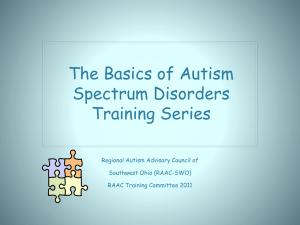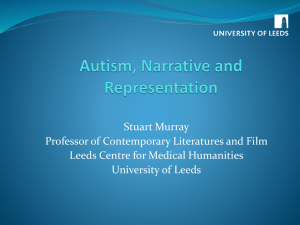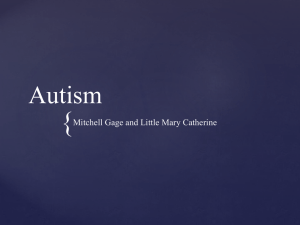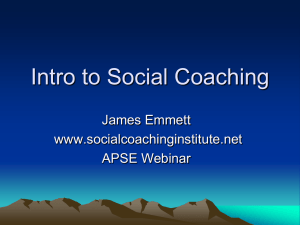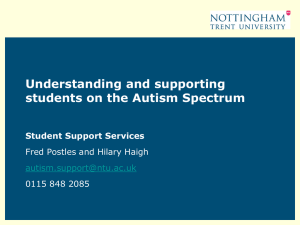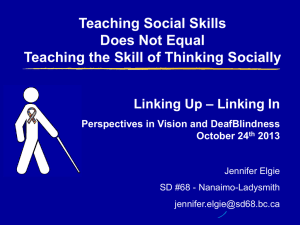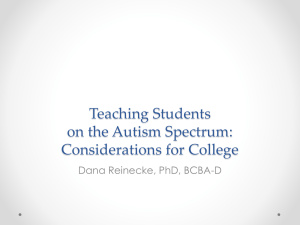I am a child with autism
advertisement
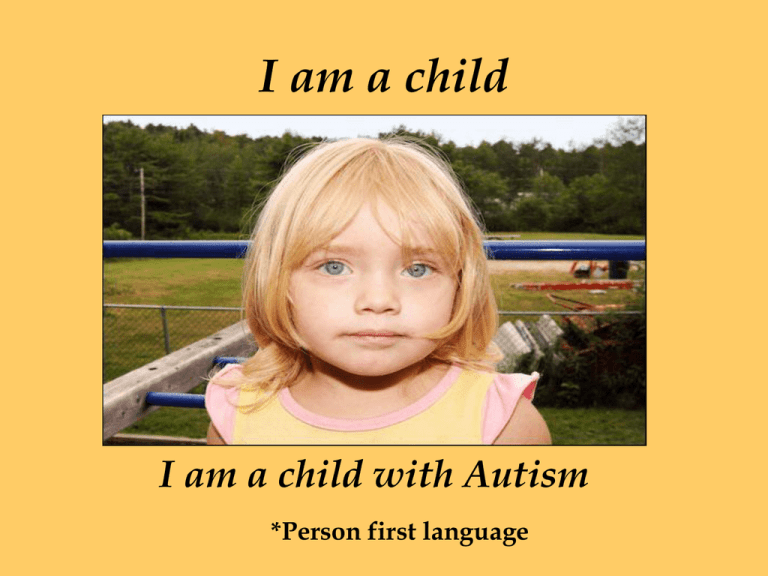
I am a child I am a child with Autism *Person first language Autism spectrum disorder Article 7 Rule 41. Eligibility Criteria a lifelong developmental disability that includes autistic disorder, Asperger's syndrome, and other pervasive development disorders, as described in the current version of the American Psychiatric Association's Diagnostic Statistical Manual of Mental Disorders. The disability is generally evident before three years of age and significantly affects verbal, nonverbal, or pragmatic communication and social interaction skills and results in an adverse effect on the student's educational performance. Other characteristics often associated include the following: 1. Engagement in: (A) repetitive activities; and (B) stereotyped movements 2. Resistance to: (A) environmental changes; or (B) change in daily routines. 3. Unusual responses to sensory experiences Autism spectrum disorder Article 7 Rule 41. Eligibility Criteria cont. Autism spectrum disorder does not apply if a student’s educational performance is adversely affected primarily by: (1) An emotional disability (2) Blindness or low vision (3) deaf-blindness (4) A cognitive disability Unless characteristics of autism spectrum disorder are demonstrated to a greater degree than is normally attributed to these disabilities. • Autism is a collection if overlapping groups of symptoms that vary from child to child. (Siegel, 1996, p.301) I am a child with Autism Repetitive Behaviors • Intense preoccupation with parts of objects or certain activities • Repetitive motor mannerisms Spinning objects Lining up toys Hand flapping Rocking Head banging •Some children engage in these activities constantly while others tend to do so when anxious, stressed, or upset * (L) Behavior can be extinguished (with rewards or consequences) Behaviors can be replaced with more socially appropriate behaviors Social Interactions • Lack of imaginary or symbolic play * Play-dough (L) • Lack of spontaneity in social interactions * Script and practice “Good morning” • Limited interest in social games • Limited interest in engaging in interactions with others • Difficulty in developing peer relationships appropriate to developmental level. * Babysitter rather that peer Social Interactions • Difficulty recognizing emotional states of self and others * Emotion cards • Passive * Can be talked into doing things by peers * Script and practice “Stop that. Go tell” I am a child I am a child with autism Cognition • The act of thinking • Cognition shapes the way people process information and relay understanding Over-selectivity • When a child looks at a picture and “over focuses” on one specific detail to the exclusion of everything else…tunnel vision • For example this picture of a child’s closet may be described by a child with autism as a picture of Arthur the Aardvark Visual Learner • Someone who learns best by watching or seeing how something is done • Show me learning •Schedules * •Choice boards •Social Stories * •Videos •Story and picture cards * Focused attention • Focused attention on a specific activity or object • May last for a long time if not interrupted • Can be very difficult to interrupt Rote memory •May repeat the entire script of a movie or video •May recall specific dates •May be able to name all of the streets in the neighborhood * • It is important to remember that autism, particularly in the area of cognition, is characterized by uneven rather than simply delayed development. • This means that is common for a child with ASD to show "splinter" skills, appearing to be highly capable in some tasks (i.e., math computation) but unable to follow simple routines independently or carry on a conversation. Concrete Processing It’s raining cats and dogs! Run to the restroom. Hop on the bus. Take a seat. Hit the lights. Communication • Delay in, or total lack of language Autism Angel Echolalia - The repetition or echoing of whole expressions Echolalia occurs in approximately 85% of children with autism who eventually develop speech • Can be used to learn language • Can be used to soothe • Can be used to communicate Communication • Lack of initiating, and difficulties sustaining conversation with others • Inappropriate display and lack of understanding body language Facial expressions, movements and gestures may not match what they are saying. Their tone of voice may fail to reflect their feelings. Some use a high-pitched sing-song or a flat, robot-like voice. This can make it difficult for others know what they want and need. Communication difficulties can lead to frustration and inappropriate behavior verbally or physically (such as screaming, grabbing or running) Processing Time • Children with autism often need A Lot of time to process information. • Giving them that time can often prevent a melt down! • Patience, Patience, Patience I am a child I am a child with autism Meet Temple Grandin Autism and Sensory Issues • The brain needs sensory information • Our brain organizes information that is received through sound, vision, smell, taste, touch and movement • Children with Autism usually react differently to sensory input • Children with autism may have issues with one or all of the sensory systems • Children with autism can be sensory seekers sensory avoiders Sensory overload demo Sound Sensitivity Clues Sound Avoiders Tries to escape from noises Puts hands over ears Hears sounds you do not even notice (like buzzing from florescent lights) Becomes upset by sirens or other loud noises Sound Sensitivity Clues • Sound Seekers Makes sounds, like humming, to block out other sounds Seeks noises (H lawn mower) Does not respond to certain sounds or name being called What can you do? Talk softly and slow down Use sound blocking headphones Use soft music or other “good sounds” to block out bad sounds Have a quiet place available Pay attention to the sounds around you and see if you can identify any possible irritating sounds…applause, crowd noise, gym or cafeteria noise, fire alarms Please keep in mind • Unexpected sounds can be frightening • A child with autism may run from distressing sounds • Sound sensitivity can be painful Visual Sensitivity Clues • Visual avoiders May be upset in cluttered places May be upset in bright lights or sunlight May be upset around florescent lighting Visual Sensitivity Clues • Visual Seekers May seek bright colors May flick or spin objects in front of eyes May stare at bright lights or moving objects (fans) What can you do? Do not insist on eye contact (but do require the person to look in your direction) Try and keep the environment as plain as possible or at least provide a clutter free wall. Let the child with autism look out of the corner of his/her eyes. What else can you do? Do not put instructional material near your face (too much visual input). If possible, do not use florescent lighting If they are seekers, provide visual stimulation…a fish tank, kaleidoscope, spinner or mobile, etc Use visual schedules and calendars and photos for seekers Smell Sensitivity Clues • Smell avoiders Breathes through mouth Avoids cooking smells Covers nose Get upset around strong smells like cleaning supplies, perfumes, bathroom odors * Smell Sensitivity Clues • Smell seekers Sniffs objects and people Holds things up to the nose Goes toward strong aromas What can you do? Try not to use scented products for avoiders Keep the environment as clean as possible Try to cover a bad smell with a good one on a handkerchief or give the child a tic tac For seekers, provide a variety of scents like lotions, spices, air fresheners, scented markers, etc Please keep in mind • Smell sensitivity is difficult. There are smells everywhere! • Smells can affect behavior • A child with autism may be so uncomfortable with the smell of urine or bowel movements, they may put off going to the restroom for as long as possible * Taste Sensitivity Clues • Taste avoiders Only eats certain foods Will not mix foods or eat casseroles • Taste seekers May prefer strong flavors and spices May like to dip food in sauces May lick or chew non-food items What can you do? Offer a variety of foods Check for smells in the room that may make it hard to eat Think about texture and temperature (sometimes they cannot tell when food is too hot) Offer safe alternatives to replace inappropriate licking or chewing (gum, mint, hard candy, etc.) Touch Sensitivity Clues • Touch avoiders May hit or withdraw when touched May have problems with haircuts or combing hair • Touch Seekers May not feel pain easily May look for rough surfaces May look for physical contact *H What can you do? Never tickle a child with autism Be aware of clothes…they may be too stiff or scratchy. Look for tags in clothes Don’t touch the child without warning them Use a firm but gentle touch…light touch is often more uncomfortable Movement Sensitivity Clues • Movement avoiders May be frightened going down stairs or on uneven surfaces May prefer to sit to avoid physical activity • Movement seekers May jump, bounce, pace, rock or twirl May be very active What can you do? Provide support. Let them know you are there to help Practice new activities when they are calm Be prepared for them to bolt if you put them in a situation that is scary for them If they are seekers, give movement breaks Provide physical work as part of a task Please keep in mind • Challenging behaviors may occur if the child with autism is not getting enough movement • Provide creative opportunities for movement such as: Jumping on a rebounder Swinging Sit-n-spin Moving books or weighted objects I am a child I am a child with autism Wrap-up 10 things every child with autism wishes you knew



